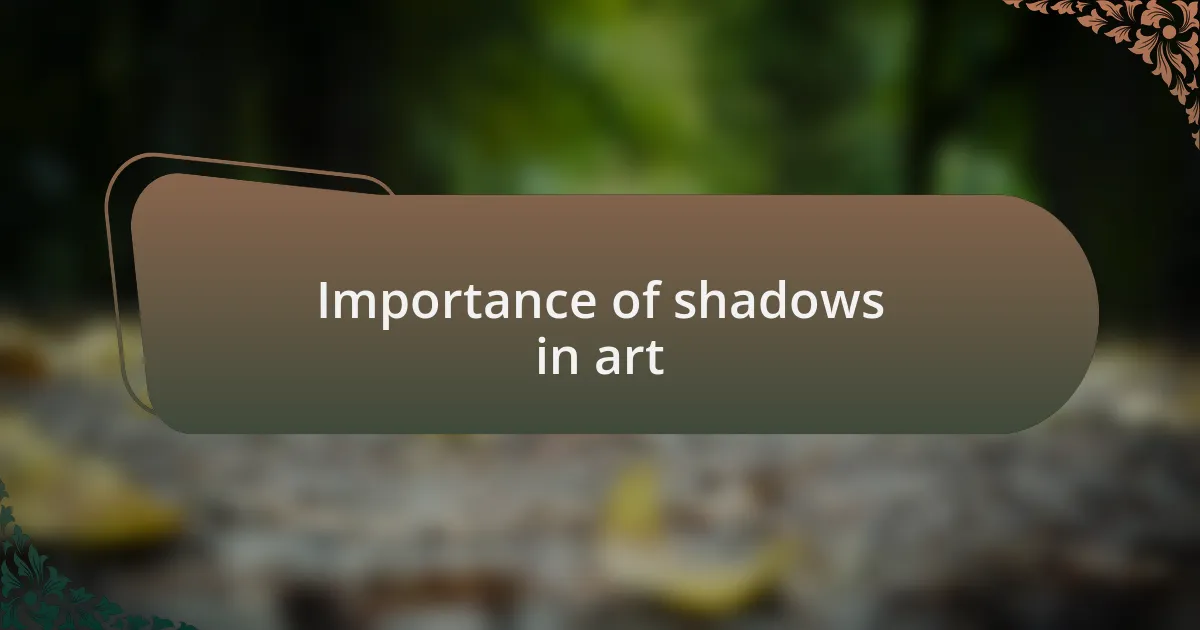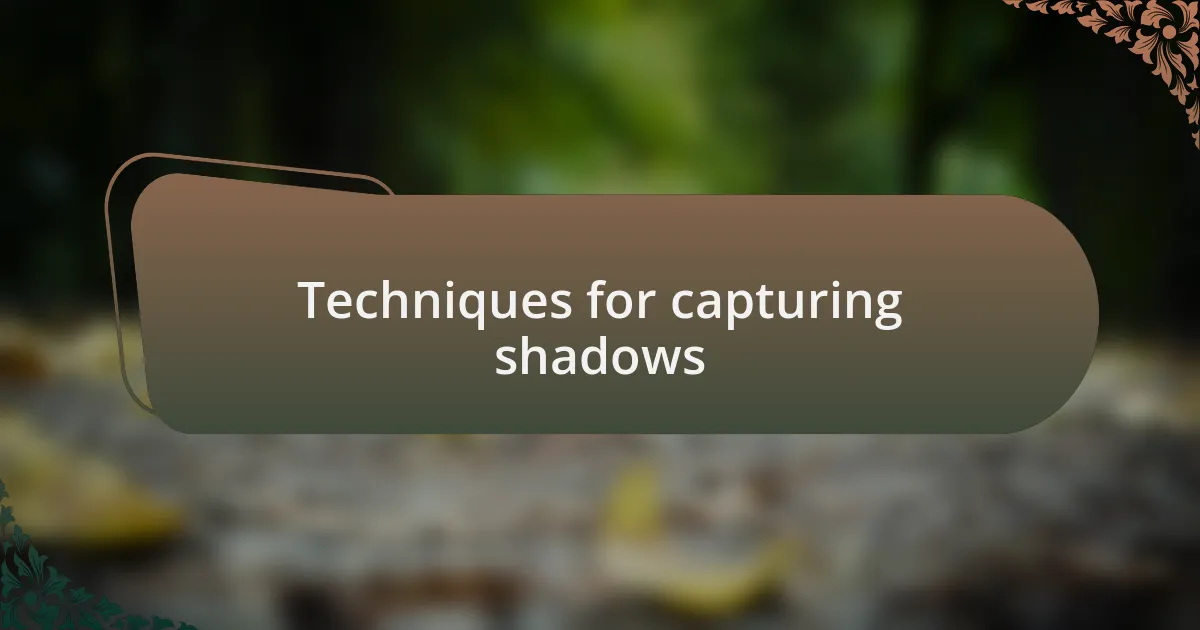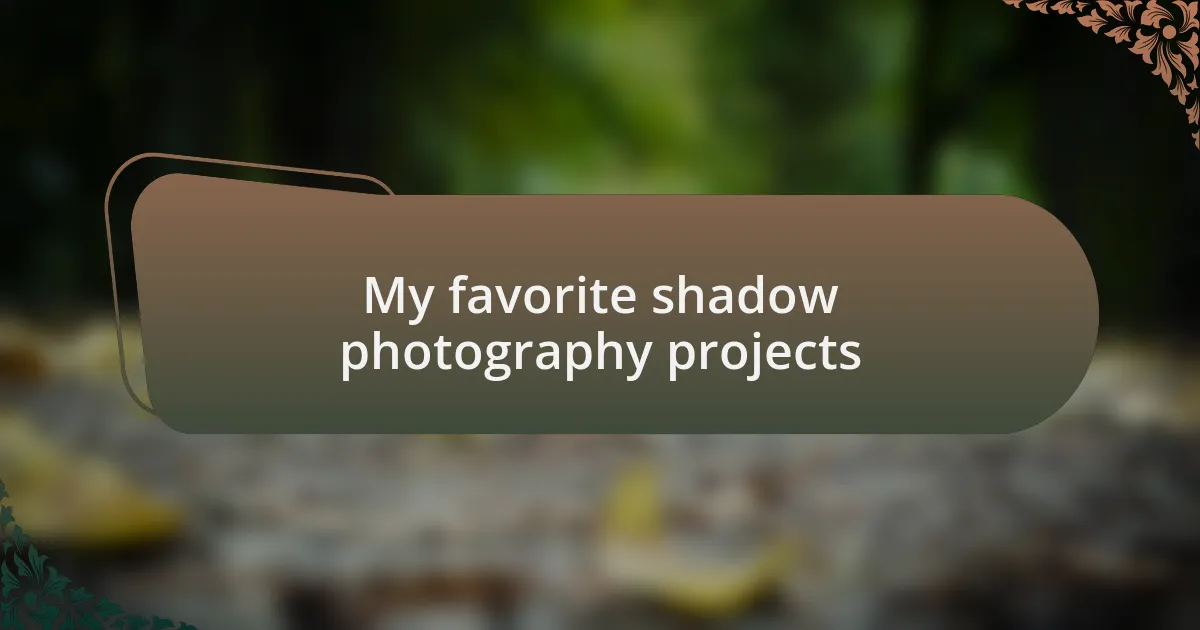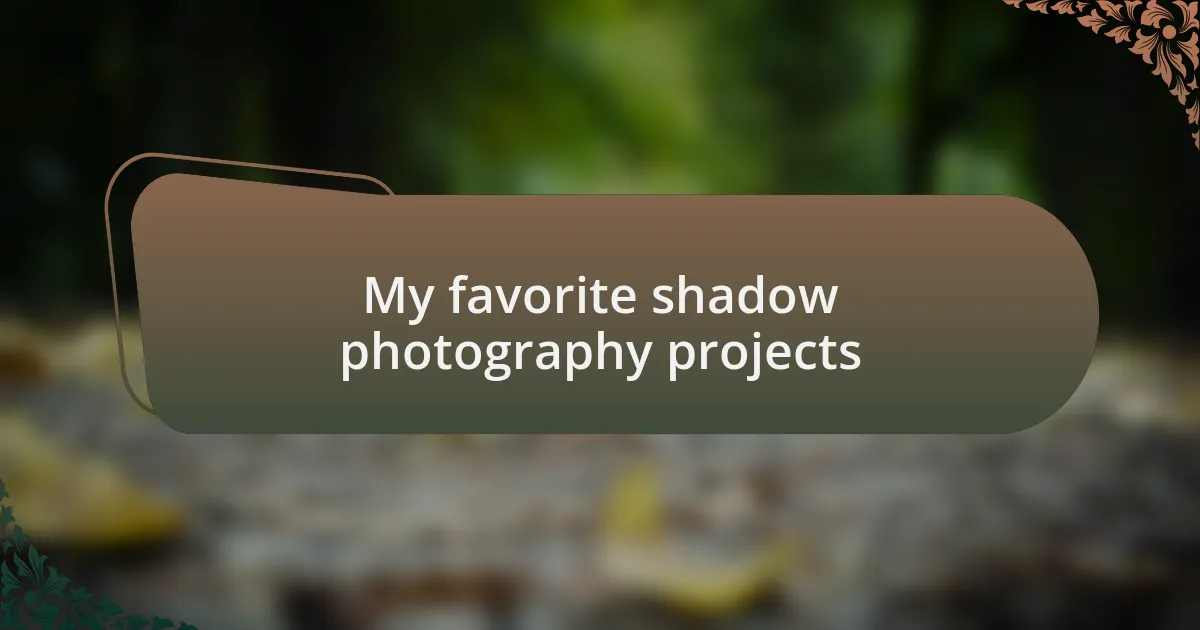Key takeaways:
- Shadows enhance mood and storytelling in photography, transforming ordinary scenes into emotional narratives.
- Understanding light direction and quality is crucial for creatively capturing shadows, influencing composition and viewer perception.
- Shadows can serve as powerful compositional elements, guiding the viewer’s eye and adding depth to images.
- Personal experiences with shadow photography reveal the deep emotional connections and memories that can be evoked through this artistic technique.

Understanding shadows in photography
Shadows play a crucial role in photography, affecting not just the aesthetic but also the mood of an image. Have you ever noticed how a simple shadow can evoke feelings of mystery or even loneliness? I remember capturing a shot of an empty swing at dusk, and the elongated shadow it cast transformed the entire narrative of the photograph, making it resonate with an eerie stillness.
Understanding the direction and quality of light is essential in manipulating shadows creatively. For instance, harsh midday sunlight creates stark contrasts, while the softer light of the golden hour produces shadows that are gentle and inviting. I’ve often found that experimenting with different times of day can lead to surprising results, and it reminds me of how often we overlook the potential of a shadow to enhance the storytelling in our imagery.
Moreover, shadows can serve as a powerful compositional element. They can guide the viewer’s eye, frame a subject, or even add depth to an otherwise flat image. In my experience, I’ve used shadows to create layers in my photographs, adding complexity that invites the viewer to linger a little longer. Isn’t it fascinating how something as simple as a shadow can add such depth and dimension?

Importance of shadows in art
Shadows in art are not merely absence of light; they provide depth and emotion to a composition. I once photographed a weathered tree against a sunset, and its intricate shadow danced on the ground, imbuing the scene with a sense of nostalgia. Don’t you think a shadow can reflect the history of a subject as much as the subject itself?
The interplay of light and shadow can evoke various moods, transforming an ordinary scene into something extraordinary. I recall a moment in an abandoned building where the sunlight streamed through broken windows, casting dramatic patterns that felt almost theatrical. That contrast brought a palpable tension that made the photograph much more engaging. How often do we overlook such fleeting moments of intrigue?
Additionally, shadows can create a sense of balance within a piece of art. They can counteract bright areas and lead the viewer’s eye through the image, facilitating a journey rather than a static view. I’ve placed shadows strategically in my work to create visual rhythm, guiding the viewer from one element to another. Isn’t it remarkable how something so simple can orchestrate the flow of our perception?

Techniques for capturing shadows
Capturing shadows creatively requires an understanding of light direction. I remember a sunny afternoon when I positioned myself strategically to photograph a model against a wall. The shadows cast by her silhouette added an unexpected element of depth, turning a simple portrait into a striking composition. Have you ever noticed how precise angles can make shadows feel like characters of their own?
Another technique I often explore is utilizing long shadows during the golden hour. I find that as the sun sets, the shadows elongate dramatically, creating immersive landscapes. Once, while hiking, I snapped a photo of a winding path with trees casting elongated shadows behind me. The image not only captured the beauty of the moment but also evoked a sense of adventure and intrigue. Isn’t it amazing how playing with time of day can transform even the most mundane scenes?
I also love incorporating high contrast imagery by shooting in harsh midday light. In those conditions, shadows become stark and pronounced, which can add a graphic quality to images. I recall taking a photo in a busy urban setting where the strong sunlight highlighted patterns of shadows cast by buildings. The resulting image felt like a snapshot of life, full of dynamic energy. Have you ever experimented with such bold contrasts in your photography?

Creative uses of shadows
Playing with shadows can add a captivating narrative layer to your images. I often find myself capturing shadows that interact with everyday objects. Once, during a street photography session, I photographed a bicycle leaning against a wall. The shadow of the bike created a dynamic contrast, almost as if it were another character in the scene. Doesn’t it make you rethink how you view ordinary moments?
I’ve also experimented with shadows in portraiture, where they can emphasize emotion and mood. There was a moment when I shot a friend sitting near a window, the late afternoon light casting intricate shadows across her face. The interplay of light and shadow not only highlighted her features but also hinted at a deeper story behind her expression. Have you tried using shadows to convey the feelings of your subjects?
Another creative approach I enjoy involves shadows as framing devices. I recall a time when I was at a local market, and I noticed how the shadows from overhead awnings framed a bustling scene below. By positioning my camera just right, I turned the shadows into natural borders, guiding the viewer’s eye into the chaos of colors and movement. Isn’t it fascinating how shadows can direct the viewer’s gaze and highlight what matters in the frame?

Personal insights on shadow photography
Capturing shadows has often felt like uncovering a hidden layer in my photographs. I remember one afternoon wandering through a park where the trees cast long, intricate shadows on the pathway. I decided to shoot the ground rather than the surroundings. The shadows created a beautiful pattern that transformed an ordinary walk into an abstract piece of art. Have you considered looking down rather than up when searching for your next shot?
Shadow play in architecture is another aspect that excites me deeply. I once found myself at a historic building with stunning columns. As the sun set, the shadows elongated and danced on the ground, bringing the structure to life in a different way. I aimed my camera to capture the architectural details highlighted by these fleeting forms. It made me wonder—how often do we overlook the interplay of light and architecture in our urban environments?
Then there’s the way shadows can evoke nostalgia or memory. I recall photographing a child playing in their backyard, the tall grass creating soft, gentle shadows. Those shapes reminded me of my own childhood, and I was able to reflect that emotion in the photograph. Can shadows evoke your memories, too, as they did for me, while also inviting others to connect with a moment in time?

My favorite shadow photography projects

My favorite shadow photography projects
One of my proudest projects involved capturing shadows during a local street festival. As the sun dipped lower, I noticed how vendors’ canopies stretched shadows that intertwined with the vibrant colors of their stalls. This juxtaposition created a visual narrative of community and celebration, reminding me how shadows can symbolize connection even without direct light. Have you ever tried to find a story through shadows in your local events?
Another memorable session took place at the beach during golden hour. I played with the shadows cast by my friends as they frolicked near the surf. The water briefly caught the light, while their figures elongated across the sand, creating whimsical silhouettes. That moment was a reminder of how fleeting joy can be; shadows captured an essence that words couldn’t convey. Do you think photographs can often embody emotions more profoundly than we realize?
Finally, I can’t forget a simple yet impactful project I did with a childhood toy, a small dinosaur figurine. I placed it against a window during a rainy day, allowing the natural light to create intricate shadows on the wall. It made me reflect on how something so small could evoke big memories of imagining grand adventures. This project taught me that sometimes the most significant artistic creations come from everyday moments. Have you explored the shadows of your past in your photography?